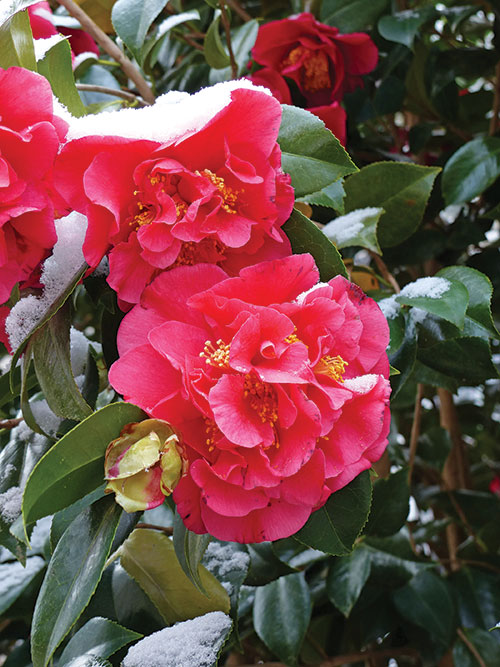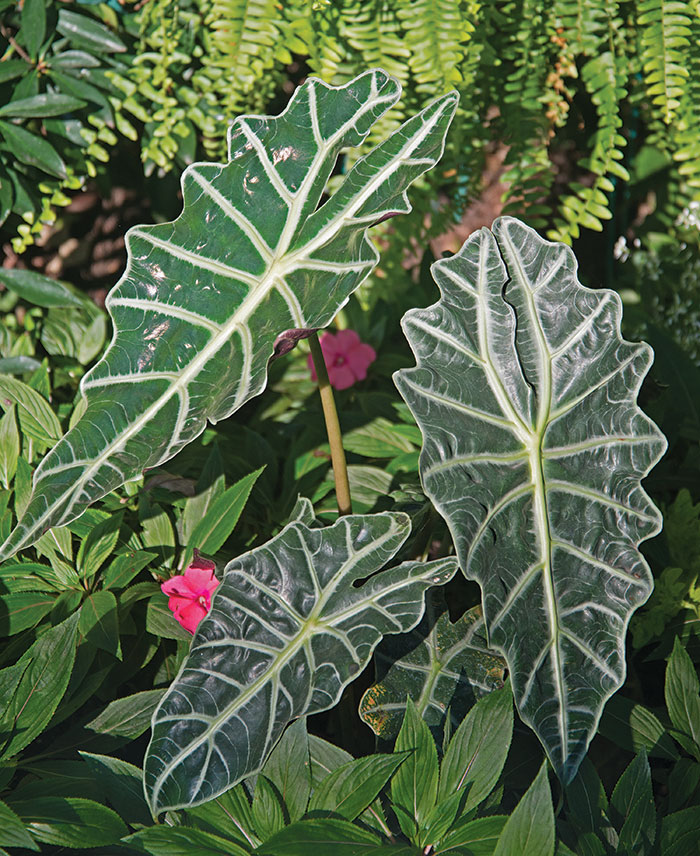“Unusual,” “strange,” “Martian,” “plastic” — these are the comments typically made about an eye-catching, striking houseplant that goes by the name of ‘Polly,’ with no reference to a parrot intended. ‘Polly’ is a tropical alocasia that found its attractive way into American homes starting back the 1950s.
And just how pretty is ‘Polly?’ Well, she is quite a visual cracker with long, arrowhead-shaped leaves so shiny they look like wax. Running through these indented, deep-emerald leaves are large, bright veins that strike like lime-green lightning bolts. That’s crackin’.
Although ‘Polly’ is an alocasia, it refuses to stick to the script. Alocasias, along with colocasias, are often interchangeably called “elephant ears” in reference, of course, to their leaf shape and large size. However, ‘Polly’ rarely reaches above 2 feet tall, making it an ideal, tame houseplant for many indoor settings.
A good location for ‘Polly’ is a room brightly washed in natural light. Just be sure to keep it out of direct sunlight — the harsh rays could singe the foliage. Avoid spots close to vents as well because the dry air can also scrunch up the leaves.
Being from the tropics, this alocasia likes medium to high humidity. In the controlled environment of a house, such a requirement can be partially met by setting the pot on top of a pebble tray that is watered often. Misting the leaves occasionally will also help, but use either rain or distilled water because some chemicals in treated city water can cause spotting on the leaves.
In the winter, ‘Polly’ will sense the shorter days and rest, so hold back on fertilizer and only water when the upper half-inch of pot soil is dry to the touch. This plant might even go dormant, losing its leaves and sending owners into a panic as to why they killed it. Have patience; wait until late winter to put ‘Polly’ back on a regular watering schedule with diluted fertilizer added at least once a month, and watch new leaves emerge to greet the young spring.
‘Polly’ can be given a vacation outdoors starting in the late spring and continuing until the end of summer. Just remember to set it in a shady spot away from the scorch of the sun and water it more often than you would indoors. Whether inside or outdoors for the seasons, site this alocasia carefully because it can be poisonous to both people and pets.
And as exotic as ‘Polly’ looks, you would think it would be hard to find. Not the case with this cutie — I have spotted it often in the houseplant sections of big box stores all over Cary, and it is a popular pretty with many online retailers.

Evergreen winter-flowering camellias are among the garden’s earliest bloomers.
Sure it’s cold, but despite New Year’s chill, the garden will slowly begin to awaken, with winter-flowering camellias (Camellia japonica) leading the charge from now until early spring with their cheerful blossoms that become more numerous as the weather warms.
But with this pretty sight comes a pretty important chore. Fallen blooms are prime breeding grounds for petal blight, a fungal disease that can misshape and discolor future blooms with ugly splotches of brown.
However, this nasty’s annual development cycle — and its impact on flowers — can be greatly reduced if spent blossoms are raked up and tossed in the trash. As a camellia’s flower show revs up to full speed during the early spring, rake underneath the bush at least once a week.
To Do in the Garden
January
- Had your garden soil tested yet? The more you know about your growing ground now, the better you will be able to tend to your plants during the growing seasons.
- Planning on starting a new planting bed this spring? Go ahead and roughly turn the soil in the area over. This will help you define the size and shape of the bed, fluff the dirt up to help prevent compaction later, and also expose any harmful insects overwintering underground to killing cold temperatures.
- It is certainly not too early to begin buying annual seeds from garden catalogs and online sites, because new and in-demand selections can sell out quick!
- Don’t let chilly temperatures prevent the garden from giving your nose a cold-weather thrill. Add such special plants as sweetbox, winter hazel, wintersweet, winter honeysuckle and winter daphne that will perfume January and February’s landscape with their hardy, fragrant flowers.
- Water gardens can freeze over during extended periods of extreme cold. Keeping the pond’s water pump going will help prevent total surface icing, as will adding a few floating rubber balls or small scraps of untreated commercial lumber.
February
- When picking out vegetable and ornamental plants for this year’s garden, consider not only disease- and insect-resistant varieties but also drought-tolerant selections.
- Notice how ornamental grasses add vertical, flowing structure and interest to the garden now; plan to plant more in future winter gardens.
- Itching to get growing in the veggie patch? February is a good time to start planting the seeds of edible-pod peas, radishes, turnips, carrots and onions.
- Even in the winter, birds get thirsty, so continue to add fresh water to the bird bath and, on those super cold days, keep it free of ice.
- Working Together for the Greater Good
- Meet Your Match
- Stellino’s Italiano
- No Standing Still for Sheila Ogle
- 2018 Maggy Awards: Lifestyle
- 2018 Maggy Awards: Restaurants
- Presenting the 2018 Maggy Awards!
- Best Nonprofits: How to help your Maggy winners
- The Dish: Kababish Café
- This Polly Is a Cracker
- 2018 Maggy Awards: Shopping
- 2018 Maggy Awards: Services







